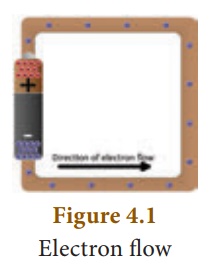Definition and SI unit - Electric Current | 10th Science : Chapter 4 : Electricity
Chapter: 10th Science : Chapter 4 : Electricity
Electric Current
ELECTRIC CURRENT
The motion of electric
charges (electrons) through a conductor (e.g., copper wire) will constitute an
electric current. This is similar to the flow of water through a channel or
flow of air from a region of high pressure to a region of low pressure.
In a similar manner, the
electric current passes from the positive terminal (higher electric potential)
of a battery to the negative terminal (lower electric potential) through a wire
as shown in the Figure 4.1.

1. DefinitionŌĆéofŌĆéelectric current
Electric current is
often termed as ŌĆścurrentŌĆÖ and it is represented by the symbol ŌĆśIŌĆÖ. It is
defined as the rate of flow of charges in a conductor . This
means that the electric current represents the amount of charges flowing
in any cross section of a conductor (say a metal wire) in unit time. If a net
charge ŌĆśQŌĆÖ passes through any cross section of a conductor in time ŌĆśtŌĆÖ, then
the current flowing through the conductor is
time ŌĆśtŌĆÖ, then the
current fl owing through the conductor is
I = Q/t

2. SIŌĆéunitŌĆéofŌĆéelectricŌĆécurrent
The SI unit of electric
current is ampere (A). The current flowing through a conductor is said to be
one ampere, when a charge of one coulomb flows across any cross-section of a
conductor, in one second. Hence,

Solved Problem-1
A charge of 12 coulomb
flows through a bulb in 5 second. What is the current through the bulb?
Solution:
Charge Q = 12 C, Time t
= 5 s. Th erefore, current I = Q/t = 12/5 = 2.4 A

Related Topics